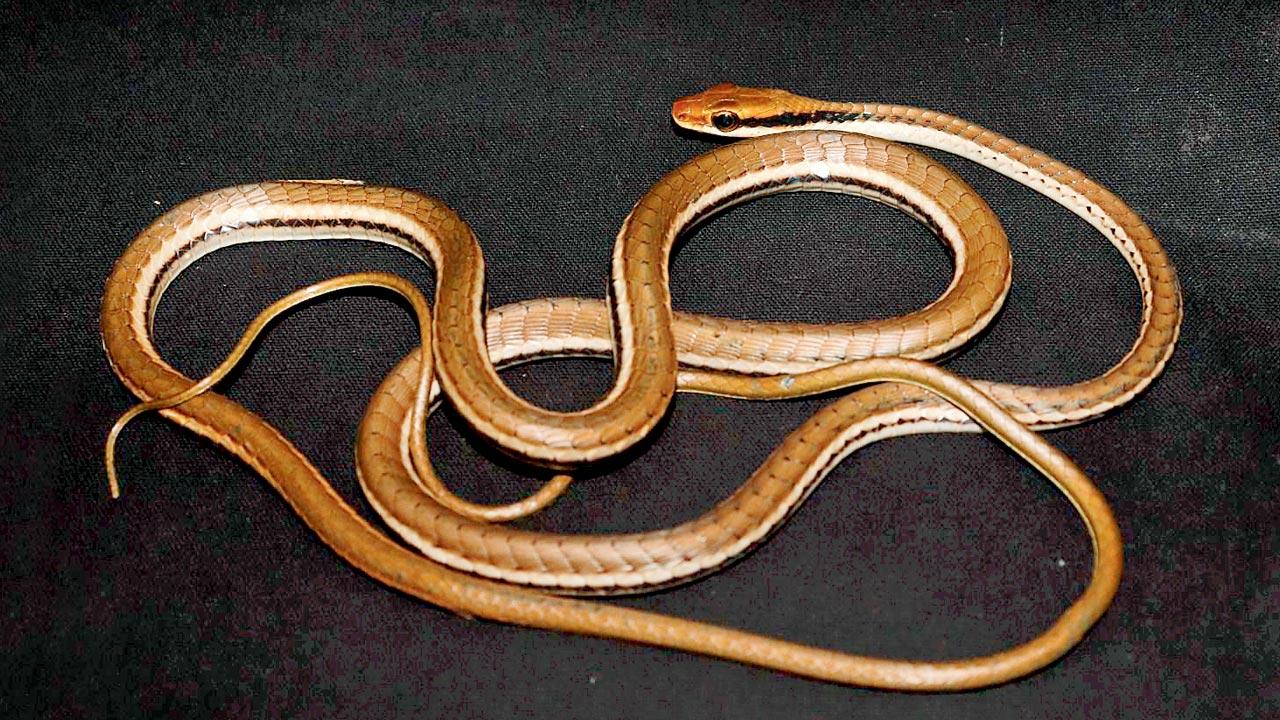The authors noted several distinct traits in these two snakes when compared to D. tristis, including a bright red tongue instead of the usual bluish-black, a shiny coppery bronze body, and dark lateral stripes. Sharma added that the scale patterns and tail shapes of these individuals were also different

The snakes have shown distinct features not scientifically identified yet. Pics/Special Arrangement
A recently published research note in a scientific journal has revealed intriguing findings about the Bronzeback tree snake. Wildlife rescuers from the NGO RAWW observed that two of the many Bronzeback snakes they had rescued displayed unusual physical characteristics.
The research suggests that these two individuals may belong to a species not yet scientifically described.

Titled Atypical Bronzebacks, Dendrelaphis sp. (Squamata: Colubridae), from Mumbai, Maharashtra, India, the note was published in the journal Reptiles and Amphibians by authors Siddharth Parab, Anil Kubal, Mahesh Ithape, Pawan Sharma, and Purvendra Jathar.
Pawan Sharma, founder and president of RAWW, told mid-day, “Between February 2021 and February 2023, our team rescued 10 adult Bronzeback tree snakes from various locations in Mumbai. Upon closer examination, eight of them were identified as typical specimens of the Indian Bronzeback (Dendrelaphis tristis), but two individuals, rescued from Kanjurmarg and Vikhroli, exhibited unusual features.”
 The snakes have shown distinct features that have not been scientifically identified yet. Pic/Special Arrangement
The snakes have shown distinct features that have not been scientifically identified yet. Pic/Special Arrangement
The authors noted several distinct traits in these two snakes when compared to D. tristis, including a bright red tongue instead of the usual bluish-black, a shiny coppery bronze body, and dark lateral stripes. Sharma added that the scale patterns and tail shapes of these individuals were also different. Photographs of the snakes were archived at the University of Kansas and verified by herpetologist Dr Rishab Pillai.
The researchers carefully documented the snakes’ morphology and compared them with other known species from the region, such as Giri’s Bronzeback (D. girii), Ashok’s Bronzeback (D. ashoki), and Boulenger’s Bronzeback (D. bifrenalis), all of which are found in southern or western India. While the rescued snakes shared certain traits with these species, they also showed unique features not seen in any of them.
“These snakes may represent an entirely new population, or even a new species. But with only two specimens and limited scientific resources, we can’t confirm that just yet,” said Mahesh Ithape, a researcher at RAWW and one of the authors of the study.
All ten snakes, including the two unusual ones, were safely released into suitable habitats after being documented.
RAWW has stressed the importance of conserving urban biodiversity and supporting ongoing scientific research.
“This discovery highlights how much we still don’t know about wildlife thriving even in densely populated cities like Mumbai,” said Sharma. “Until now, we have focused on rescue, treatment, and rehabilitation, but we are now planning to establish our own research wing — non-experimental on live animals — as we see a gap that a dedicated team can meaningfully address.”
10
No. of Bronzeback tree snakes that were rescued
 Subscribe today by clicking the link and stay updated with the latest news!" Click here!
Subscribe today by clicking the link and stay updated with the latest news!" Click here!










